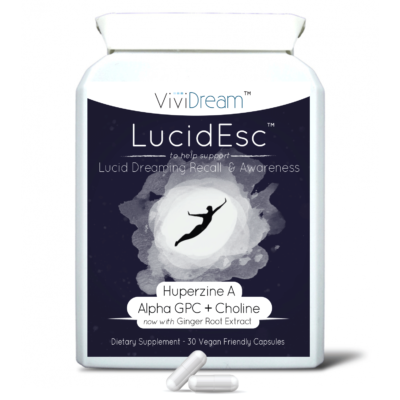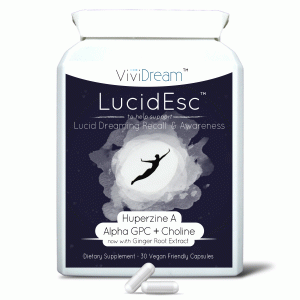
7 Other-Worldly Facts About Lucid Dreaming

Lucid dreaming happens when you’re aware you’re within a dream. This means that you can experience ANYTHING you can think of: flying at breakneck speed, having sexual experiences, or even meeting your childhood heroes. Here are some fun & interesting facts about this phenomenon.
#1. The first time lucid dreams were recorded was by Tibetan Hindus & Buddhists.
The concept of lucid dreaming may seem modern but it is quite ancient. There are speculations that ancient Egyptians also tried lucid dreaming…
But the very first recorded document that mentions lucid dreaming originates from before 1000 BCE from the Upanishads, the Hindu oral tradition of spiritual lessons, philosophy and proverbs.
The one text that has survived the cultural fusion of this Hindu practice with the practices of Buddhism is the Tibetan Book of the Dead, conservatively dated to the 8th century.
Its partial translation in 1935 by Walter Y. Evans-Wentz was the first time a Western audience, primarily historians and occultists, learned of these ancient practices.
These ancient dream practices later influenced dream scholars in the 20th century, eventually leading to scientists officially recognising it in 1978.
Our next fact continues the story of Tibetans…
#2. Tibetan Buddhist monks use lucid dreaming on their path to enlightenment.

It shouldn’t come as a surprise that even today, Buddhist monks actively use those ancient lucid dreaming practices.
Tibetan Dream Yoga is the original form of lucid dreaming that’s been documented for at least 1,000 years.
Just like our Westernised understanding of lucid dreams, the initial aim is to awaken the consciousness in the dream state.
The philosophy of Tibetan Buddhism is complex, but you don’t need to be an expert to practice dream yoga techniques. However, you do need to show commitment; a technique is only as good as you are prepared to work at it.
One very broad but basic rule is this: continually compare your dreams to waking reality and know what it feels like to be conscious. This will increase your self awareness and you will find it easier to induce lucidity in dreams.
However, it’s likely that your goal with lucid dreaming isn’t to find your inner self or achieve enlightenment. Don’t worry, you’re not alone.
#3. Flying and sex are the most popular activities when it comes to lucid dreaming.
The researchers in a 2014 study surveyed about 570 people who said they’ve experienced lucid dreaming.
They asked the participants what they’ve dreamt about, and which activities they decided?—?when they were awake?—?to try to do in their dreams.
About 350 of the participants provided examples of the actions they planned to accomplish in their lucid dreams.
Most often, they wanted to try things that are impossible in real life, such as flying, doing magic, breathing under water etc.
But the participants also reported planning to carry out everyday activities in their dreams, such as having sex and doing sports.
Though, maybe your dreams look more like a video game…let’s see why that might be a good thing.
#4. Video games may help to achieve lucid dreaming.

Turns out that all those hours spent playing Mario or Assassin’s Creed can greatly help you out when it comes to lucid dreaming.
The link? Both represent alternate realities, said Jayne Gackenbach, a psychologist at Grant MacEwan University in Canada.
“If you’re spending hours a day in a virtual reality, if nothing else it’s practice. Gamers are used to controlling their game environments, so that can translate into dreams, ”
Gackenbach told LiveScience in 2010.
Her past research has shown that people who frequently play video games are more likely than non-gamers to have lucid dreams where they view themselves from outside their bodies; they were also better able to influence their dream worlds, as if controlling a video-game character.
Additionally, both gamers and lucid dreamers displayed traits like intense focus and superior spatial awareness in their waking lives.
Next fact is a great reality check to confirm that you’re in a dream.
#5. You can’t read while dreaming, or tell the time.

If you are unsure whether you are dreaming or not, try reading something. The vast majority of people are incapable of reading in their dreams.
The same goes for clocks.
Each time you look at a clock it will most likely tell a different time and the hands on the clock won’t appear to be moving, as many lucid dreams have reported.
This phenomenon happens because during a dream, the part of the brain responsible for logic and intellect shuts down, allowing us to accept crazy dream stuff as reality while at the same time messing with our ability to interpret letters and numbers.
Hence why this is an amazing reality check that can help you with lucid dreaming. If you notice a sign, a clock in your dream, but it looks blurry or the characters are constantly shifting, you’re in a dream.
But as it turns out, a lot of people had already had a lucid dream happen to them randomly.
#6. Around 55% of people have experienced lucid dreaming at least once in their lives.

To figure out just how common lucid dreaming is worldwide, UK researchers at the University of Northampton looked at all research on the subject published between 1966 and 2016.
Their meta-analysis of 34 studies revealed fairly consistent findings across time and geographic borders.
In most countries, roughly the same percentage of people say they know what it’s like to participate in their dreams.
About 55 percent can check lucid dreaming off their bucket lists. And almost a quarter are frequent lucid dreamers, meaning they report at least one lucid dream per month.
Compared to middle-aged and older adults, younger people appear more susceptible to frequent lucid dreaming.
This can be explained by the idea that lucid-dreaming frequency should peak during the teen years and level off during early adulthood, at which point rapid neural growth seen during adolescence is ended.
And to wrap it up…
#7. LucidEsc is the only VEGAN lucid dreaming supplement on the market.
If the lucid dreaming practice has been interesting to you for a while, but you’ve been turned off by all the animal products contained in many supplements, LucidEsc is the right solution for you.
Great care has been taken to ensure the perfect lucid dreaming enhancement formula, all while keeping the ingredients vegan-friendly.
To find out more about the ingredients and science behind LucidEsc, go here.
[TheChamp-FB-Comments]
Sources:
http://dreamstudies.org/history-of-lucid-dreaming-ancient-india-to-the-enlightenment/
http://www.world-of-lucid-dreaming.com/10-things-you-didnt-know-about-lucid-dreaming.html
https://www.ncbi.nlm.nih.gov/pubmed/24934010
http://www.world-of-lucid-dreaming.com/dream-yoga.html
https://www.livescience.com/6521-video-gamers-control-dreams-study-suggests.html
https://bookriot.com/2016/10/04/do-you-read-in-your-dreams/
https://vanwinkles.com/how-common-is-lucid-dreaming
https://www.quora.com/What-are-some-amazing-facts-about-lucid-dreams






